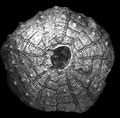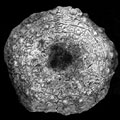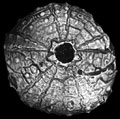The Echinoid Directory
Contributed by Andrew Smith, April 2011
Bandelicyphus Geys, 1992, p. 145
| Diagnostic Features |
|
|---|---|
| Distribution | Turonian, Egypt |
| Name gender | masculine |
| Type | Bandelicyphus qenaensis Geys, 1992, p. 145, by original diagnosis. |
| Species Included | Only the type species |
| Classification and/or Status | Camarodonta; Temnopleuroida; Glyphocyphidae |
| Remarks | This taxon closely resembles Rachiosoma and Glyptocyphus in appearance and in apical disc and ambulacral plating, but according to Geys (1992) has perforate tubercles. Most Glyphocyphidae have monocyclic apical discs but their ambulacra are trigeminate and their tubercles perforate. Hemidiadema has a similar apical disc and ambulacral plating, but it differs in having only a single column of large ambulacral tubercles in each zone at the ambitus. Geys, J. F. 1992. Regular echinoids, other than Hemicidaroida, from Upper Cretaceous deposits in the Wadi Qena-area (Eastern Desert, Egypt). Bulletin de l'Institut Royal des Sciences naturelles de Belgique. Sciences de la Terre 62, 139-154. |




